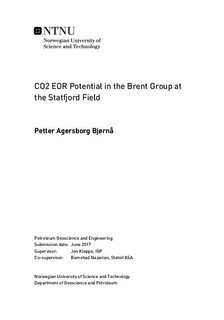CO2 EOR Potential in the Brent Group at the Statfjord Field
Master thesis
Permanent lenke
http://hdl.handle.net/11250/2615076Utgivelsesdato
2017Metadata
Vis full innførselSamlinger
Sammendrag
CO2 flooding is an enhanced oil recovery (EOR) technique that can be used to improve displace- ment efficiency and volumetric sweep efficiency. This is due to its favorable interactions with oil, which can be beneficial when trying to produce incremental oil. This method has been in- vestigated in this thesis.
Statfjord is one of the largest oil discoveries in Europe, and has been producing oil since 1979. The main reserves are in the Brent group, and production from this reservoir is supposed to stop in 2025. A compositional model of the Brent group has been developed by Statoil, which is tuned to reflect the status in the reservoir in 2031. This model is used in this thesis to study the CO2 EOR potential for the Brent group, and see how much extra oil that can be produced by using CO2. Simulations on a field scale level have been performed, but also a pair of an injector and a producer has been studied for looking at injection strategies and compositional effects.
The best scenario in this study can increase the oil recovery by 5.4% of the original oil in place (OOIP), by injecting 22 million tons of CO2 per year over a 25 year period. 3% of the OOIP can be produced by injecting 5 million tons of CO2 per year, for the same time period. Unless the CO2 can be brought to the oil field for 10 USD/bbl or less, the net present value (NVP) of the project is negative. For all the scenarios simulated, at least 72% of the CO2 injected will be stored in the reservoir. A reinjection of the produced gas seems to have a positive effect on the oil production, and if it is reinjected the storage percentage of CO2 can reach 100%. Continuous injection of CO2 has given the best results of the injection strategies studied in this thesis.
